#Old Achaemenid
Explore tagged Tumblr posts
Text
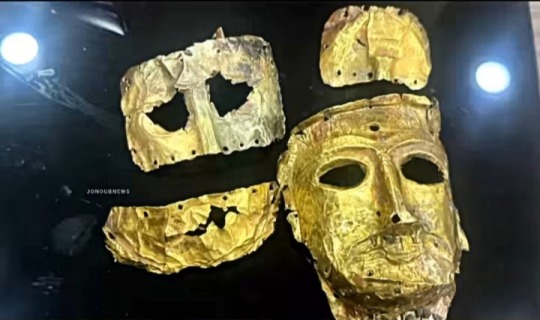
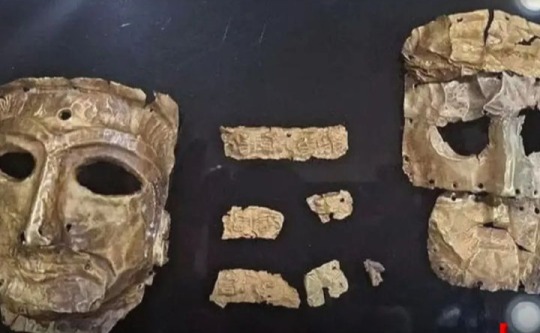
Discovered almost 3 days ago in the south of Iran (shiraz)
Unbelievable! 0_0
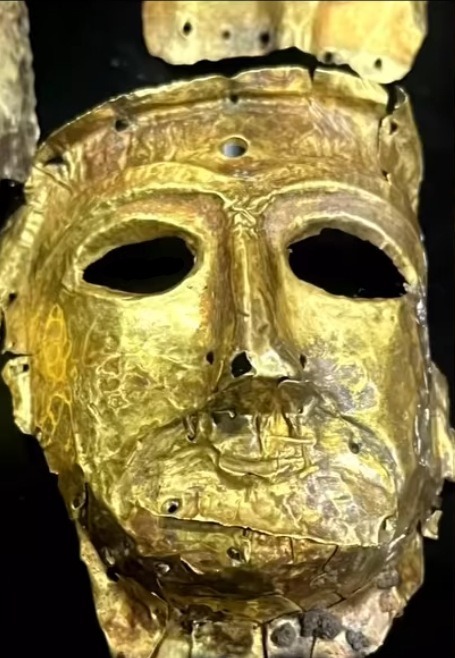
According to archaeologists, these objects(two masks and a few piece of bracelet made of gold) are more than 2000 years old and goes back to the pre-Achaemenid empire period and the late Elam area
#treasure#achaemenid#ancient history#history#mask#braclets#treasures#gold#persian empire#kingdom of heaven#fandom#king baldwin iv#area#baldwin iv#kingdom of heaven 2005#the leper king#kingdom of heaven fandom#art#koh fandom#koh#artists on tumblr#old#iran
100 notes
·
View notes
Text

at an excavation of the Tachara in Persepolis, c. 1930
#nanashi mumei#hololive#holocouncil#archaeology#persepolis#tachara#darius i#achaemenid persian empire#was looking at too many cool old archaeological drawings lmao#gotta step up my hatching game....#comic#wlart#williamleonard
381 notes
·
View notes
Text

Themistocles and Pausanias
The two generals of the Greco-Persian wars who turned their loyalty afterward (or rather, we are sure that Pausanias did, not so for Themistocles).
Pausanias and Themistocles corresponded with each other and that made some people speculate that Themistocles was also a traitor.
Here, Pausanias is showing Themistocles a jewel with the Achaemenid Empire symbol and Themistocles is... considering it.
#tagamemnon#themistocles#pausanias#ancient greece#achaemenid#greco persian wars#digital art#artist on tumblr#does this count as old man yaoi?
6 notes
·
View notes
Text
The Real World Influences of Kingdoms and Empires: II
And here's an example of what you'll find in the FREE Patreon posts!!!
Unlike the first one, this is specifically only for the Belthean Empire as a unified polity. In the next post in the Real World Influences, I'll talk about the Old Kingdoms in the empire that used to be independent.
Belthean Empire
The Holy Belthean Empire, at least societally and culturally is inspired from a mix of both Imperial China and the Achaemenid Empire in core with lots of Roman Empire in the exterior.
I wanted to create an empire that was advanced culturally, militarily, and scientifically while also boasting a diverse and cosmopolitan background. And to that end I settled on specifically the Tang Dynasty and the empire of Cyrus the Great. The Roman Empire is already known for this of course, but not in the way the other two were (depending on time period of course).
Some Belthean Emperors were also inspired by entire Dynasties of Imperial China!
For instance, Emperor Garland the Founder is pretty much the Qin Empire. He personified the violent rise of the Qin, their brutality, and his historic feat of uniting his people under one nation.
His son however, Emperor Daerin I is the early Han Dynasty instead, using more peaceful and careful methods of uniting the people after the brutality that brought his people together in the first place. His philosophy is also studied and followed by the Master-Scholars of Jelaytha, and is very reminiscent of teachings of Confucius. We'll see more when Master Feren teaches us.
Emperor Valerion is the Song Dynasty, who helmed the Belthean Empire's path to more intellectual pursuits. This min-max focus led to the establishment of the Imperial Libraries, the social change of the nobility shifting to becoming scholar-nobles for a generation in order to join the government because of the new civil service examination system, and advancements in technology and medicine with many new inventions being made during this period.
Emperor Elric I was inspired from the Yuan Dynasty. Constant wars, battles, heavy taxation, and still using the intellectual systems created by the previous ruler (dynasty) it all came to an end with a massive rebellion.
Emperor Cenric however, is the only emperor on this list that isn't inspired by the dynasties. He is instead inspired from Ahoska the Great's legend of pacifism after a brutal conquest. His story instead deals with the literal nuking of the City of Farghas.
His son, Emperor Saldwin, is mostly associated/inspired by the Ming Dynasty. His major naval expedition, the incredible international prestige gained, and the beginning of a world superpower was created with his reign. The tribute and supplication of the powers around him, the incredibly effective and brutal methods of suppression of traitors and enemies, and the pivot to keeping the peace later on while having been militaristic earlier are similar in vein of the Yongle Emperor of Ming.
And now we have Emperor Elric II, the start of the three generations that are considered by me to be of the early half of the Tang Dynasty. If his father can be considered Trajan, Elric II can be considered Hadrian. Elric II did his best to solidify the gains his father conquered, and honorably upheld the multiple treaties signed. Under his reign, a true golden age descended upon the empire.
Emperor Daerin II inherited a strong, peaceful, stable, rich, and thriving empire. He also inherited when he was nine years old. His mother, who was supposed to be the first empress of the Beltheans, had died giving birth to him, and Daerin II's uncles died from freak accidents. So when the previous emperor, his grandfather died clutching his heart in the fables gardens of Emperor's Circle, a child took the helm of the strongest nation of the world. This led to a gaping hole in the political landscape of the empire, allowing for factions to wage wars of intrigue, using assassinations, intimidation, blackmail, and seduction. It is only because of the regent, his father-in-law, that the empire did not openly give way to civil war. Daerin II's excesses, and the regents, politicking, and young age of his coronation, are all inspired by the late Han Empire, that gave way to the Three Kingdoms Period.
And finally, Emperor Otto. I'd rather not spoil anything regarding this man. Our maternal grandfather is a complex figure, one who left his mark upon history, and whose presence will still be felt even after he passes. The empire has enjoyed an unprecedent era of peace and progress that started from Emperor Otto's grandfather, Emperor Elric II. His reign enjoyed an unbroken period of peace that lasted almost 40 years, and Otto's own father Emperor Daerin II, waged what the empire considered a minor conflict on the border with the Tripartite Alliance. The empire didn't face major mobilization until Emperor Otto's invasion of Lymark, which he conquered with incredible ease and dismantled the Tripartite Alliance while gaining the Kingdom of Argent as "Imperial Friend and Ally". For all intents and purposes, the Belthean Peace remains unbroken and steadfast.
The Fashion
When they landed on Nareth's shores, the Belthean people were primarily very consistent with what one could describe as "culturally Chinese" fashion, traditions, and cultural norms. Belthean noblewomen would mostly wear clothing like below (Tang Dynasty era) and dress up with heavy cosmetics and elaborate hair styles (of which most was wigs).

The men wore the typical robes associated with modern period dramas of Imperialist China, (they mostly didnt change much throughout the dynasties and ages lol, but this is because it was considered formal wear and was meant to show respect to your ancestors which makes sense.)
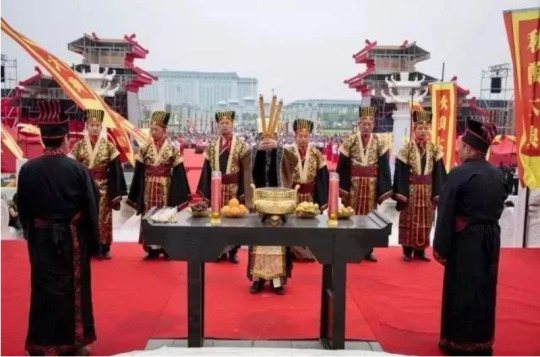
But for daily use clothing, you'd mostly see a more unisex hanfu style clothing that allows for easy movement. Another reason why I chose the Tang Dynasty in particular is due to the influx of foreign influence that helped ease restrictions on women (at least until the An Lushan Rebellion made the Tang distrust foreigners in the later half of their Dynasty) and that even extended to fashion.
Instead of the heavy and bothersome clothing of before, a noblewoman could use the ruqun style of clothing (or pair the ru with a shankun which were a style of trousers = pants!) for everyday shit while still looking fabulous.
The ru is a jacket of sorts (they could and can be longer sleeved)


And the qun is a skirt (which can also be longer, more elaborate, and made of varying different materials that further make it special and pretty)

And when used together you get the ruqun
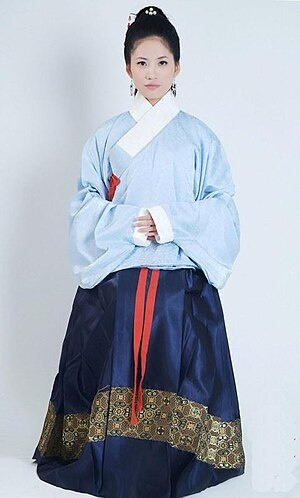
And they could absolutely be used by the nobles who could also make them incredibly pretty and of higher quality material so it wouldn't even look out of place in parties and the like.

You can even throw another bigger overcoat and make it look way more hanfu (more formal and imperial court approved)
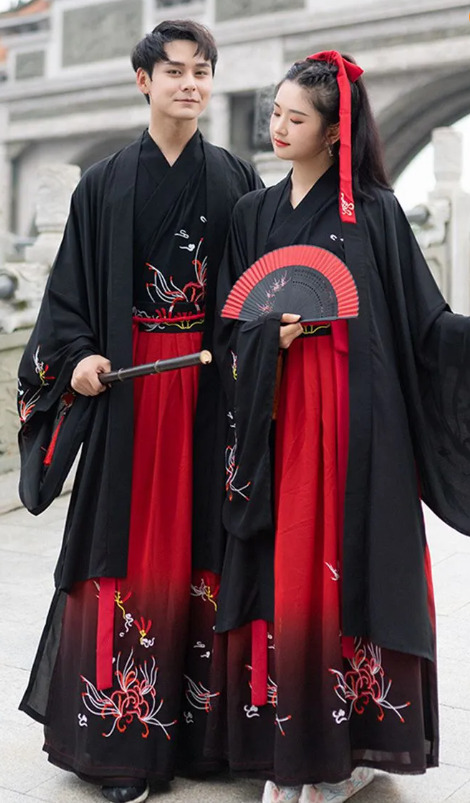
Of course, while the above is still used (and can be worn by our Champion as well if they wish as it is considered a middle ground for the traditionalists and progressives) by the empire, there is a divide currently going through fashion (and of course socially) of those staying true to their heritage and those wanting to experiment in accordance to influences from their regions (Ulthred, Moresaine, Beautrix, Swainea, Trevalyn, and now Lymark).
As such, western style of dresses and suits have begun to spread from Jelaytha and Trevalyn, who are ALSO the most merchant-like and most adventurous folk in the empire who travel around bringing their fashion and ideals to the rest of the empire.
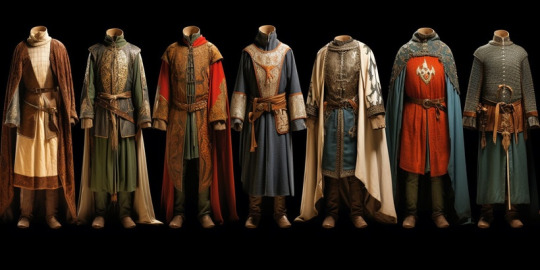

This dynamic has resulted in a wide variety of styles of hanfu and ruqun/fashion and what can be considered traditionally western-style gowns and suits.
For instance, this can create a situation where a traditionalist house may use sewing, weaving, and construction techniques the Jelaythans and Trevalyn people have created to make hanfu and ruqun outfits like below that show off their house sigil (in this case a deer). Talk about hypocrites lol

As an author, I really want to use the different regions of the empire (for it is huge and a mix of different cultures and peoples) to help explain/explore the vast history of Chinese fashion. So I may fuck around and describe an outfit that may not be period-appropriate but meh it's fantasy and the only people who'd get pissed are people super interested in a niche subject who really shouldnt get angry when im bringing this to a lot of more people lol
An artist named lilsuika (

#worldbuilding#choice of games#interactive fiction#interactive novel#kingdomsandempires#hosted games#choicescript#dashingdon#fantasy worldbuilding#fantasy world
119 notes
·
View notes
Photo
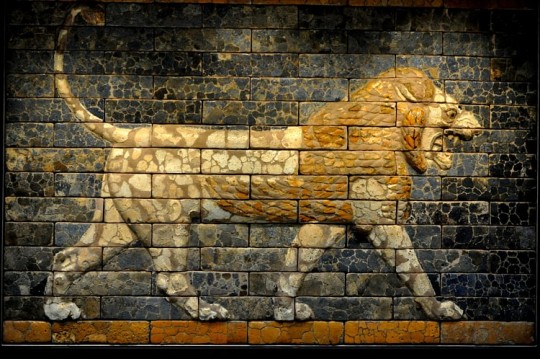
Mesopotamian Art and Architecture
Ancient Mesopotamian art and architectural works are among the oldest in the world, dating back over 7,000 years. The works first appear in northern Mesopotamia prior to the Ubaid Period (c. 5000-4100 BCE) and then developed in the south during the Uruk Period (4100-2900 BCE) in Sumer which established the first historical civilization.
According to some scholars, the works of the Indus Valley Civilization (c. 7000 to c. 600 BCE) pre-date those of Mesopotamia, but the Indus Valley developments do not appear until the Early Harappan Period (c. 5500-2800 BCE) by which time Mesopotamian works were already established. Early artwork and construction are evidenced in northern Mesopotamia at sites such as Göbekli Tepe (c. 10,000 BCE) and Ҫatalhöyük (c. 7500 BCE), both in modern-day Turkey, and Tell Brak (c. 6500-5000 BCE), in Syria.
The development of these works then progressed through the following eras, though, owing to space limitations, the Hittite and Kassite periods will not be addressed:
Ubaid Period – c. 5000-4100 BCE
Uruk Period – 4100-2900 BCE
Early Dynastic Period – 2900-2334 BCE
Akkadian Period – 2334-2218 BCE
Ur III Period – 2047-1750 BCE
Old Babylonian Period – c. 2000-1600 BCE
Hittite Period – 1700-1200 BCE
Kassite Period – c. 1595 to c. 1155 BCE
Assyrian Period – c. 1307-912 BCE
Neo-Assyrian Period – 912-612 BCE
Neo-Babylonian Period – 626-539 BCE
Achaemenid Persian-Sassanian Persian Period – c. 550 BCE to 651 CE
Artworks included reliefs, sculpture, statuary cast in metal, ceramics, jewelry, cylinder seals, stele & monuments, obelisks, and wall paintings. Mesopotamian monumental architecture is epitomized by the ziggurat, but the Sumerians were also responsible for the first large-scale palaces and temples, as well as urban planning, the arch, canals, and aqueducts, landscaped gardens, and architectural ornamentation. These early innovations would become more refined in the region through succeeding periods and influence the works of other cultures in the Near East and Mediterranean regions.
Earliest Sites & Base Materials
Although the Göbekli Tepe site is dated to c. 10,000 BCE, the first permanent settlements in that area are thought to have been established earlier, and, possibly, for the sole purpose of building the structure which most scholars believe was a temple. Göbekli Tepe is among the earliest sites, along with others such as Nevalı Çori (also in modern-day Turkey), to feature monumental architecture – including the oldest known megaliths in the world at Göbekli Tepe – as well as reliefs.
Architecturally, the site is comprised of circular areas and rectangular buildings with T-shaped pillars of limestone, some carved with images of wildlife in low and high relief. There is little evidence of human activity in the sculptures which seem to emphasize the natural world and, in some interpretations, the people's relationship with their gods. Some scholars associate the site with the later settlement of Ҫatalhöyük, though this claim has been challenged as the design of Göbekli Tepe, and the tools found there, differ from the later site.
Whatever purpose Göbekli Tepe originally served, it was a communal site associated with ritual, while Ҫatalhöyük was entirely residential. No public buildings have been found at the site which is comprised of tightly clustered mudbrick residences accessed by ladders or steps from a hole in the roof. Artwork from the site includes murals and statuary – such as the famous Seated Woman of Ҫatalhöyük – as well as ceramics. The artwork seems to focus on the natural world and the concept of fertility as several pieces represent female figures and erect phalluses.
The people of Ҫatalhöyük used clay, limestone, marble, and other materials for their statuary and paint created from natural substances. The figurines, statuary, and murals are usually interpreted as representing religious concepts, but this claim is not universally accepted. There is no evidence of urban planning at the site; it seems to have developed organically with buildings attached to each other and people using the rooftops for communal activities and movement as there are no streets, courtyards, or public squares.
Continue reading...
123 notes
·
View notes
Text
Ancient World Dashboard Simulator

🐢 aristotlestortoise Follow
I'm so sick of these philosophers waving dead chickens around to prove their point like that's not contributing to unnecessary food waste when children are starving in Gaul

🦷 diogenessimp Follow
and who says they didn't eat the chicken afterwards you presumptuous garum sipper
besides how would that benefit a starving child in gaul diogenes did that in athens thats like 6000 stadia away from gaul

🐢 aristotlestortoise Follow
As if donating a day-old chicken that had been used as a prop isn't a hazard for food poisoning or something geez
How about you bring in a live chicken and demonstrate your point with that and then donate it to a godsdamned farmer who can do something with it

🦷 diogenessimp Follow
look neither of us understands diogenes whole school of thought as well as he does and if he thinks using poultry for props is the best choice then imma trust he knows what he's talking about

🦣 giantwoolybones
do you guys know that you are arguing about a dead chicken
24,874 notes

👨👦 corophilus

not to be an art critic on main or anything but has this sculptor ever heard of a dynamic pose
#a boy this age would be moving!!
3 Notes

✊ p-o-p-u-l-a-r-i-s Follow
The people just don't seem to care about how Caligula keeps beginning new construction projects with public funds. People are homeless and starving and he puts up a new theater in the middle of the city as if we need that.
Now he's claiming to be a god?? Plus there's rumors he has sex with his horse.
It's very important that you contact the members of the senate to let them know the people are ready to rise up if they don't depose Caligula. We should get organized and flood the streets.

🎽 crixusstan
I see you not reblogging this. Come on, this should have 200k notes
14,381 Notes

💸 achaemenid Follow
Dude, this invention of the coin is so iconic. Cyrus is gonna go down in history for this one. I mean that in a good way.

🪙 lydianmetallurgy Follow
Sorry but Cyrus stole the entire concept of the coin from us and I'm sick of people acting like we didn't have contributions to make to advancements in science and culture just because we were conquered by your stupid empire. Cyrus is a tyrant and just wants to gather as much power as he can.

🦁 daniyye
Cyrus let my people go back to our homeland, so he's all right by me
#by the rivers of Babylon we sat and wept when we remembered Zion #now we don't have to do that anymore!!
18 Notes

🥇 gladiatorheadtohead Follow
Remember, you're voting for who you think would win the fight, not who you like the best.
24 Notes

🐺 lyca
just left my den and there's just 2 human babies lying on the ground all alone
wtf do i do

🐺 lyca
so i happen to already be lactating so i guess... i just have 2 more cubs now?

🐺 lyca
guys these babies are so cute. i think they're going to do great things one day
#personal #do not reblog i mean it this time 6 Notes

🍆 miletus-leather Follow

The best sex toy shop in Miletus. Come see our selection!

🦌 artemisbow Follow
I'm not one to harsh on a small business trying to make it but I've been to this shop and women are an afterthought here. You'd think the only people interested in dildos were men the way they act here.

🍆 miletus-leather Follow
Women should be weaving and taking care of their children, not coming into our sex shop.

😈 hermescock Follow
K

🐐 blessedsatir
U
64 Notes
#dash simulator#dashboard simulator#ancient rome#classical rome#ancient greece#classical greece#ancient persia#ancient israel#ancient lydia#bonus since i know you want to know gaul was 13000 stadia from athens
513 notes
·
View notes
Text

Mania (active during the 5th to early 4th century BCE) served as the governor of Aeolis and led armies as a vassal of the Achaemenid Empire.
Her husband, Zenis of Dardanus, had governed Aeolis for the satrap (provincial governor) Pharnabazus II. When Zenis died of illness, Mania petitioned Pharnabazus, who had initially planned to appoint a man as her husband's successor. However, Mania sought the position for herself. According to Xenophon, she approached Pharnabazus with a large retinue and many gifts, both for him and to win favor with his concubines and the influential men at his court.
Her request was granted, and Mania became “mistress of the province”. She governed effectively and led successful military campaigns. She expanded her territory, capturing the cities of Larisa, Hamaxitos, and Kolonai with a force of Greek mercenaries. Mania also accompanied Pharnabazus twice in battle. Impressed by her abilities, he rewarded her and sometimes sought her counsel.
Polyaenus praised her as an exceptional general:
“She always went to battle drawn in a chariot; she gave out orders while in action, formed her lines, and rewarded every man who fought well, as she saw he deserved. And – what has scarcely happened to any general, except herself – she never suffered a defeat.”
Mania was over 40 years old (c.399 BCE) when she was murdered by her son-in-law Meidias, who reportedly claimed that “it was a disgraceful thing for a woman to be the ruler while he was in a private station.” Meidias also killed Mania’s 17-year-old son.
He then asked Pharnabazus to grant him control of the territory, but Pharnabazus rejected his gifts, stating that “he would not wish to live if he failed to avenge Mania.” Eventually, Mania’s cities were seized by the Spartan general Dercylidas. Meidias thus gained nothing in murdering Mania.
Here is the link to my Ko-Fi. Your support would be much appreciated!
Further reading:
Polyaenus, Stratagems in war
Xenophon, Hellenica
#mania#history#women in history#historyedit#women's history#ancient history#ancient world#warrior women#female generals#Achaemenid Empire#historical figures#4th century BCE#5th century BCE
136 notes
·
View notes
Text
Conlanging Issues: A Compendium
NOTE: This question was submitted before the Nov 1, 2023 reopening and may not adhere to all rules and guidelines. The ask has been abridged for clarity.
Most of my questions are about linguistics. […] One of the major locations in my story is a massive empire with cultural inspirations ranging from North Africa in the far south to Mongolia/Russia in the far north […] The middle region is where the capital is and is the main root of culture, from which Ive been taking inspiration from Southwest Asia […], but most notably southern regions of India. I've tried to stick to the way cities are named in Sanskrit-based languages but added the names of stars to the front (because the prevalent religion of this region worships the stars [...]). So Ive ended up with names like Pavoprayag, Alyanaga, Alkaiduru, Alcorpura, Cygnapete, etc. Is this a consistent naming system or should I alter it in some way? The empire itself is named the Arcana Empire since [...] each act of my story is named after a tarot card [...]. Another region in my story is based more on parts of South China and North Vietnam, so I've tried to stick to names with a Chinese origin for that. I understand the significance of family names in southwest [sic] Asia, so I wanted to double check [...]. They have only two short given names. Based on the birth order of the child, the first half of the name comes from the fathers family and the second half from the mothers family. It is seen as disrespectful not to use both names because using only one is seen as denouncing that side of your family. Thus I have names like Su Yin, Dai Jun, and Yi Wen for some of the characters from this region, and the city itself that they are from is named Bei Fen. On the other hand, Im having further trouble naming characters. […] Ive been trying to give my human characters names from real human cultures to distinguish them from the website-generated names of say, orcs, elves, dwarves, etc, but I think I should change many of the names Ive used to be more original and avoid fracturing real world cultures for the sake of my worldbuilding. […] Im still very weak in the linguistics area (even after four years of French, sigh) and am having trouble finding where to read about naming patterns so I can make new ones up. I read your naming guides but am still having trouble on where to start for specific languages. […] Im trying to look into Sanskrit, Turkish, and Persian specifically.
You're Going Too Broad
In my opinion, you’re casting too wide a net. You mentioned looking into Sanskrit, Turkish, and Persian to develop fantasy names. These languages are very different from one another, so unless you’re using them separately for very different parts of your world, it will be hard to draw inspiration from them in a way that makes sense. You’re taking on a huge amount of research in order to worldbuild cultures that span a massive geographical area (basically all of North Africa and Asia?) and have very little in common. Are you sure you want to take on that task?
I could see it being more manageable if most of your story is set in a small region of this world, which you will then research in depth to make sure you’re being as specific as possible.
Taking Persian as an example, you’ll have to decide whether you want to use Old Persian, Middle Persian, or Modern Persian. Each of these comes with a different alphabet and historical influences. They’re also associated with different periods of time and corresponding cultural and social markers. Once you’ve decided exactly when and where you want to start from, you can then expand the borders of your area of focus. For example, if you’ve decided to draw inspiration from Achaemenid Persia, you can then look at the languages that were spoken in the Achaemenid Empire. A quick Google search tells me that while Old Persian was the empire’s official language, they also used Aramaic, Akkadian, Median, Greek, and Elamite (among, I’m sure, many many others and many more regional variations). Further research into each of these will give you ethnic groups and bordering nations that you can draw more inspiration from to expand out your worldbuilding.
Don’t forget to make sure you’re staying within the same time period in order to keep things consistent. It’s a lot of work, and this is only for a small portion of the continent-spanning worldbuilding you’re trying to do.
You can get away with painting the rest of the continent in broad strokes without too much depth if the story doesn’t go there and you don’t have any main characters from those parts of the world. Otherwise, you’ll need to put this same level of detail into your worldbuilding for the area with Turkish-inspired names, and again for the area with Sanskrit-inspired names, and so on.
I know this isn’t what you were asking, but I honestly have a hard time helping you figure out where to start because your ask is so broad I don’t quite know where I would start myself. So, this is my advice: focus down on one region and time period and go from there. Feel free to write back once you’ve picked a narrower focus that we could help you with.
- Niki
So there’s logistical issues in regards to your naming system for southern China-coded regions. One issue is history: mainly on how there is not simply one language in China but multiple due to having a lot of ethnic groups and the size of China. South China in particular has different dialects and languages than the North as seen in this map of Chinese languages and dialects. There’s also how historically Mandarin was not the official language until 1913 in China and historical China saw vast changes in territory dependent on the dynasty. Before then, Mandarin was primarily a northern Chinese language based in Beijing while southern China had its own languages, dialects, and dynamics. Not to mention, historical China saw an evolution of language just like English has Old English, Middle English, Early Modern English, and Modern English. For instance, Vietnam was once part of China during the Tang Dynasty and at another point, it was not part of China.
-Mod Sci
If You’re Borrowing Whole Words or Elements, Research More
The other issue is inconsistency with the cultures you’re deriving this conlang from. In regards to “two given names,” the Chinese name I was given was one syllable and then I would have a last name that was also one syllable. There’s also how not every family is perfect. Not every marriage is sanctioned and some children may come from single parents. Some families may not cooperate with marriage and sometimes children may be abandoned with unknown parents. There does not seem to be contingencies for these names under this conlang system.
The main problem with conlangs is that one needs to truly understand the languages one is drawing from. Tolkein managed to create conlangs due to training in linguistics. Mandarin is already a difficult language with multiple tones, and trying to use it for conlangs without knowledge of how Mandarin works or a good foundation in linguistics is just a Sisyphean endeavor.
-Mod Sci
Four years of French wouldn’t have taught you about linguistics as a science or anything about the language families you’ve listed - Indo-Iranian, Sino-Tibetan, and Turkic, nor any Asian naming conventions. I agree with Niki that you need to narrow down your research.
Pur/pura means city in Sanskrit (ex: Gurdaspur, Hoshiarpur). Prayag is a place where pilgrimages are done. Naga isn’t a place name in Sanskrit (google says it means snake), nagar is and it means town. X Nagar is a very common name for places (Ex: Rajinder Nagar). Many cities in Karnataka have names ending in uru (Bengaluru, Mysuru, Mangaluru, Tumakuru, etc) but the language of Karnataka is Kannada - a Dravidian language and completely different family from Sanskrit (Indo-Aryan). I’m not sure where “pete” came from. “Bad” and “vaal” are common suffixes for places too (Ex: Faisalabad, Allahabad). A disclaimer that I do not speak Sanskrit, I speak Punjabi, which is a descendant of Sanskrit and in the same linguistic family (Indo-Aryan languages).
- SK
Also, This Is Not…Really Conlanging.
Hi OP. Linguistics refers to the science of studying how languages work, not the discipline of learning languages. And nothing shows that gap more than how you have thus far approached constructing fictional languages and toponyms.
The reason why Sci and SK have a lot to say about your place names is because they don't resonate—you have borrowed whole words into your toponyms (place names) from a variety of languages—without an accurate understanding of what these words mean, how they’re pronounced, where they’re derived from—and expected them to work together. I suggest you read the links below on why conlanging is not as simple as choosing some languages and mashing their IRL words together:
Why Using Random Languages Wholesale in your Fantasy is a Bad Idea
Pitfalls of Mashing Countries and Languages in Coding
In your city names, for example, you’re using star names from multiple languages that use different sets of sounds represented by different sets of historical spelling rules. “Cygn-” and “Arcana” stick out like a sore thumb—the fact that one “c” is /s/ and one is /k/ is an obvious flag that they are Latin-derived English borrowings. This is because spelling rules were created in Middle English to make sense of the mix of “c” pronunciations across words of Indo-European origin due to a historical split called the Centum-Satem division. This is a phenomenon that is very specific to our world history, and to the history of English at that. Ironically, in your attempt to avoid stock fantasy names (which also often fall into the Latin-derived English pit), you are taking the exact same approach to naming.
Like Niki said, your selections are far too broad to code under a single umbrella. Do you expect that whatever language that city name came from runs the full gamut of sound inventory & spelling variety that spans multiple continents and hundreds of languages? Because that’s not how languages work. (And yes, I mean hundreds. Indigenous languages and linguistic diversity are a thing. See Niki’s note about just the languages in Persia. And nation-states bulldozing over those languages and pretending it’s just one language is a thing. See Sci’s note about China.) I haven't even talked about the variation in morphology (how words are formed) or syntax (sentence structure).
Please just read or re-read my guide on “naming conlangs” in this post and start from there.
~ Rina
PSA ON CONLANGING AND FANTASY NAMES:
For fantasy language asks submitted after Nov 1, 2023, the asker must indicate that they have read Mod Rina’s conlanging posts linked in FAQ 2 (Guides and Posts by Topic) of the Masterpost under the question “How do I make a fictional language for my story?” While this is an older ask, we are posting it as an example to our followers.
Per our new rules, any questions that can be directly answered in or extrapolated from the FAQs, or questions that indicate that the relevant resources haven’t been read, will be deleted with a note in the Deletion Log explaining why.
As always, if this post was helpful or educational to you, please consider tipping the relevant mods: SK, Niki, Sci, and Rina.
Edited for terminology errors
327 notes
·
View notes
Text

Elisabet Bclan
Persepolis, Iran // August 2018
Persepolis (/pərˈsɛpəlɪs/; Old Persian: 𐎱𐎠𐎼𐎿, romanized: Pārsa; New Persian: تخت جمشید, romanized: Takht-e Jamshīd, lit. 'Throne of Jamshid') was the ceremonial capital of the Achaemenid Empire (c. 550–330 BC). It is situated in the plains of Marvdasht, encircled by the southern Zagros mountains, Fars province of Iran. It is one of the key Iranian cultural heritage sites and a UNESCO World Heritage Site since 1979. - Wikipedia
51 notes
·
View notes
Note
Could you tell me more about your take/takes on human Elita?
And do you have any ideas for Human Optimus? I'd like to hear that too 😁
ofc!! I have stuff for tfone, aligned/prime and earthspark but as of rn only aligned is the most developed followed by earthspark lol, but I'm gonna include all of them so there's gonna be quite a bit
My tfp Elita is Argentine with major face claim inspo from Anya-Taylor Joy!! (who I think would be an AMAZING elita if they do another celeb cast for her) with her name being Ariel Caballero (meaning knight/horseman)

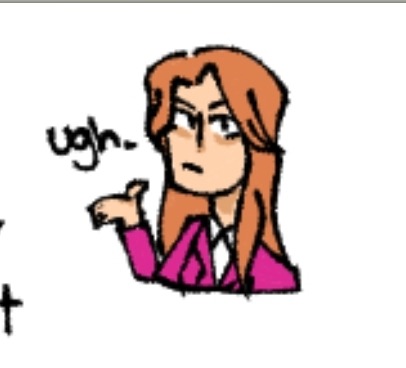


(this art is like almost 2 years old lmao 😭) she had strawberry blonde hair and a plethora of pink suits (like 2 years ago I had a humanformers boarding school au so a lot came from that) and she's sisters with chromia and moonracer! She'd be first lady (with op being prime minister ?? president ?) and military commander, and the niece of alpha trion! her not being in tfp gave me a lot of free reign omg 😭
I do have a human OP design!!! only tfp rn tho 😭 i'm thinking of ones for tf one and genuinely earthspark reminds me of a basic ass european descent grandpa so that's basically it for es 😭
He's Greek-Persian! (tho, general Achaemenid empire descent), I can't remember the name I actually gave him but I do remember Orion was his first name (he either had pax, a greek surname or a persian one 😭)

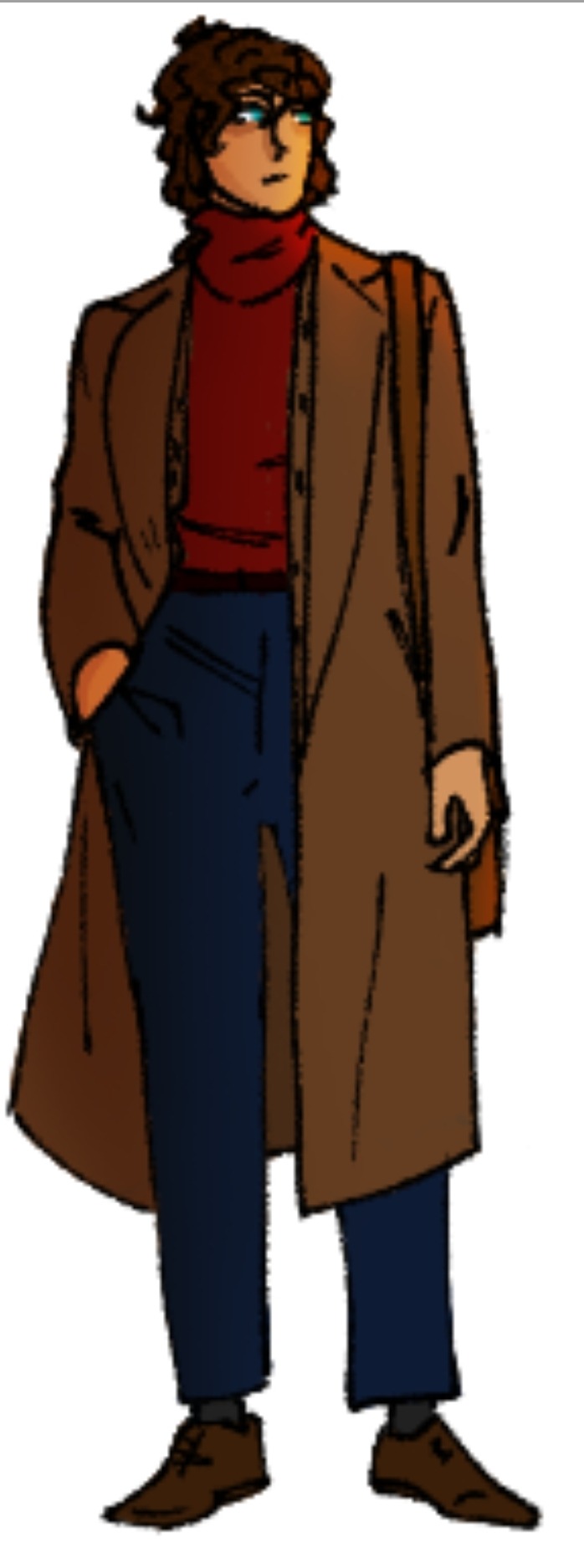
(ref by kibbitzer for the one on the right!!!!) Also old art lmao, he wasn't developed as far as elita was but i don't think that'd be a shocker based on my account 😭 He actually has freckles now but at the time of drawing those he didn't :')
back to the regular elita programming nowjdks
My earthspark Elita is Japanese!
Bushida Aeri is her name :) Bushida meaning warrior and Aeri being from ariel. I don't have many drawings for her but there's thesee



the first one is an old design for her but I still think it fits, the second being a younger Elita so like ig when she'd be Ariel in earthspark time line and the bottom is my most recent sketch of her!! I don't have a face claim inspo for her but Elita in general (not just earthspark) has always reminded me of Irene of Red Velvet! both leaders in pink lmao
For tfone there's like nothing new at all except this art

Esita Won, she's of Indian and Chinese descent, but mostly Indian, she probably speaks Punjabi or Tamil (ik completely different areas of India 😭), she reminds me of that one desi older sister who takes no crap and is not afraid to beat your ass and also makes the best curry idk
I noticed a lot of Elita's helm designs lean into traditional east Asian hair styles and clothing so I really wanted to represent those parts of her designs and the franchise's Japanese heritage :))
(omg i didn't realise how long this would end up being 😭😭)
#some times a girl has to self project her ethnicity onto her comfort characfer#I actually have a bunch of tfp human designs including arcee bee and ko moonracer lmao but they're all old#I repeated a lot I told you before sorry😭#transformers#elita one#elita 1#tf one#tf one elita#earthspark elita one#tfp elita one#Elita-1#Elita-One#humanformers#Orion Pax#optimus prime#fan art#transformers art#maccadam#maccadams
26 notes
·
View notes
Text
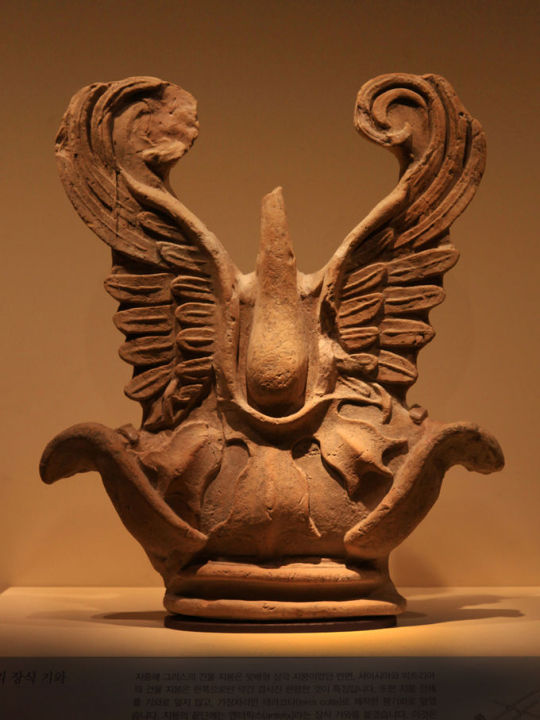


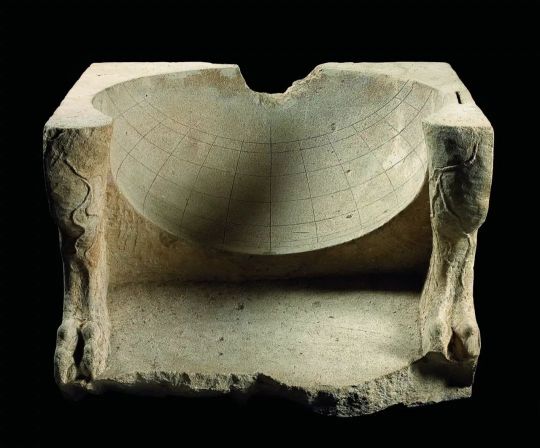
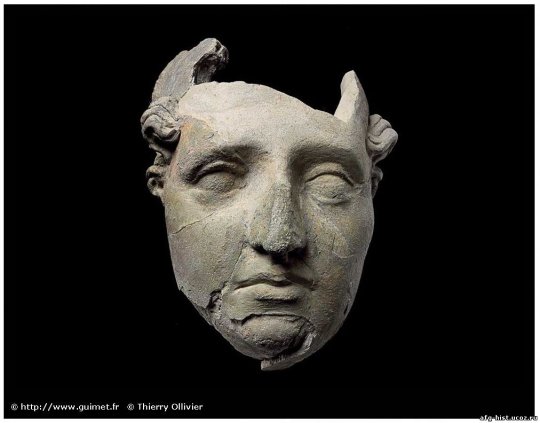
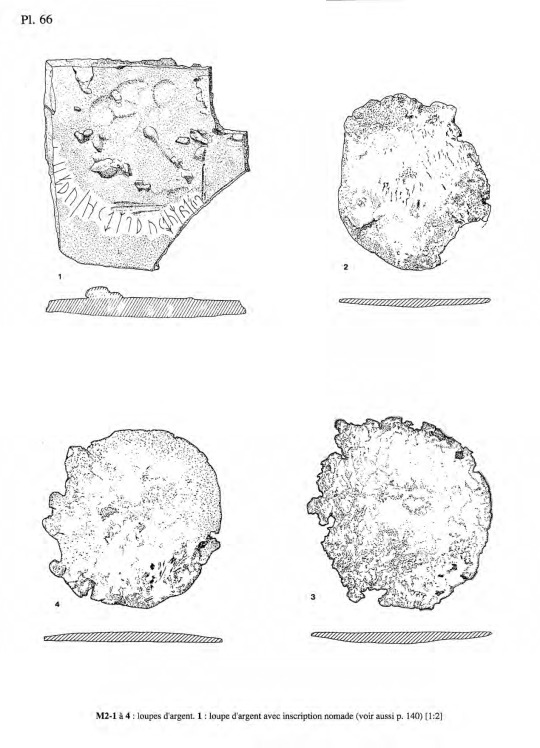
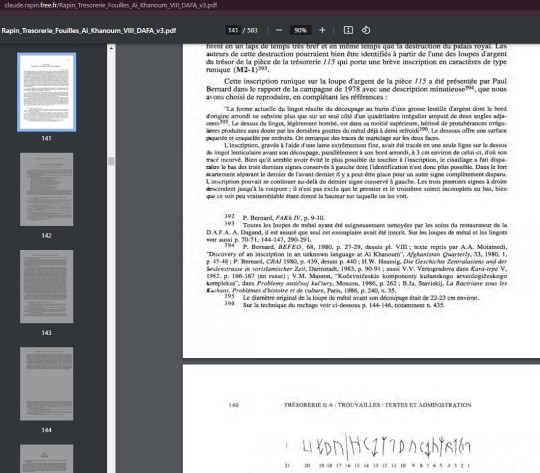
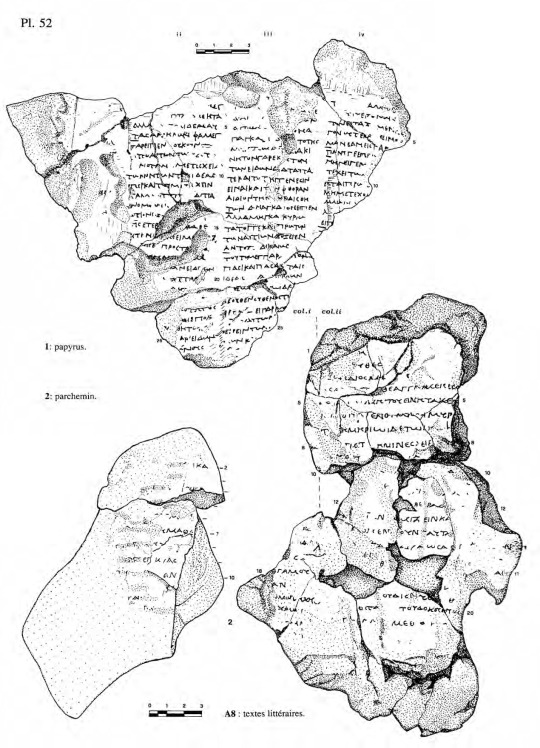
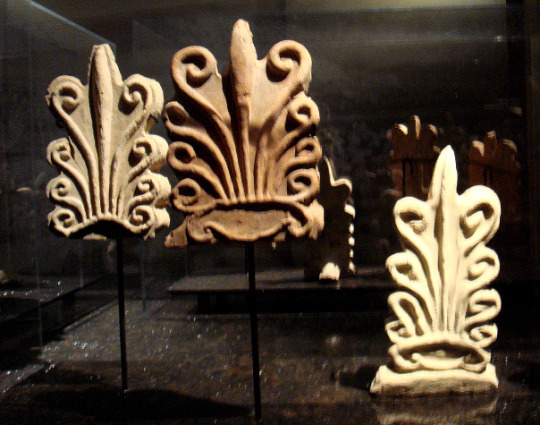

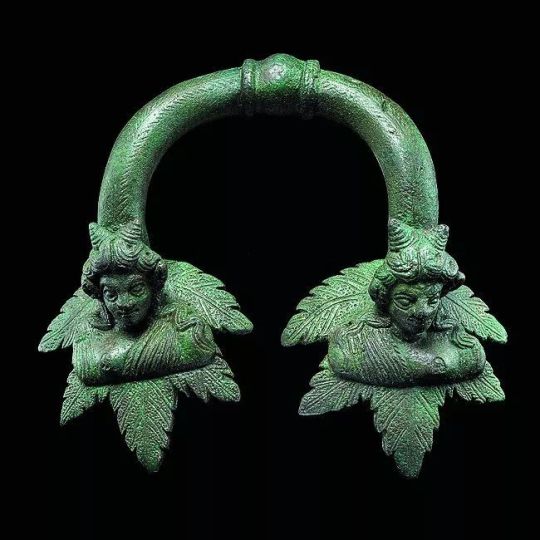


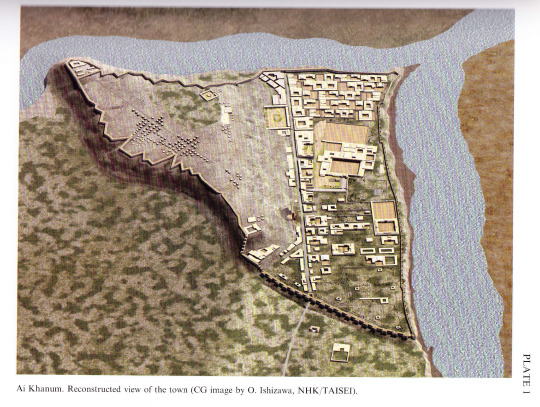
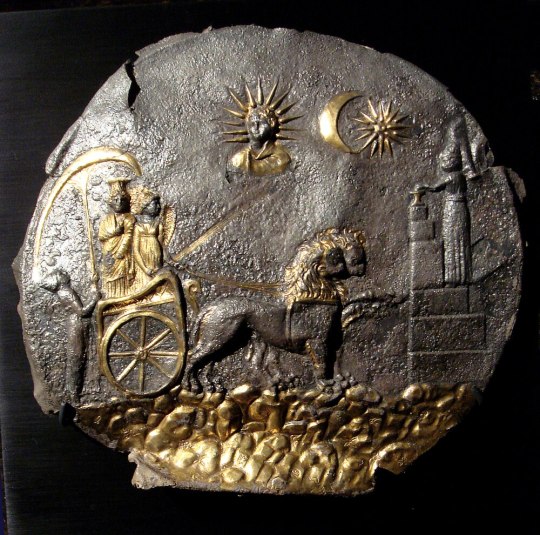

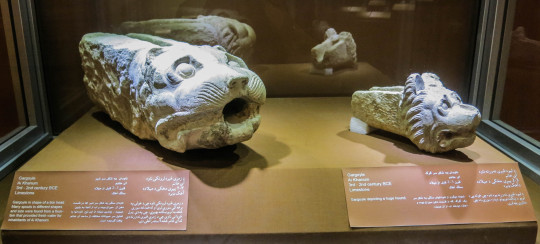

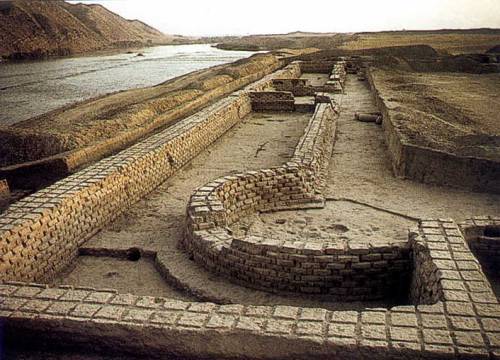


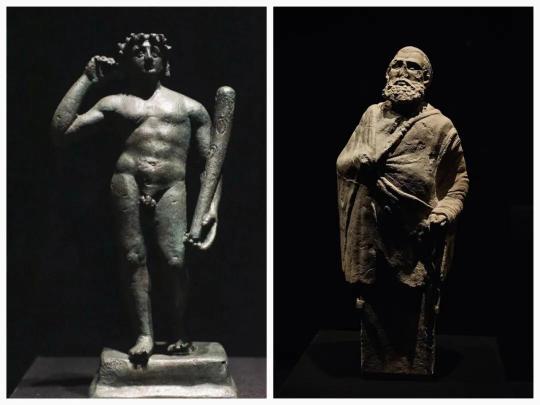
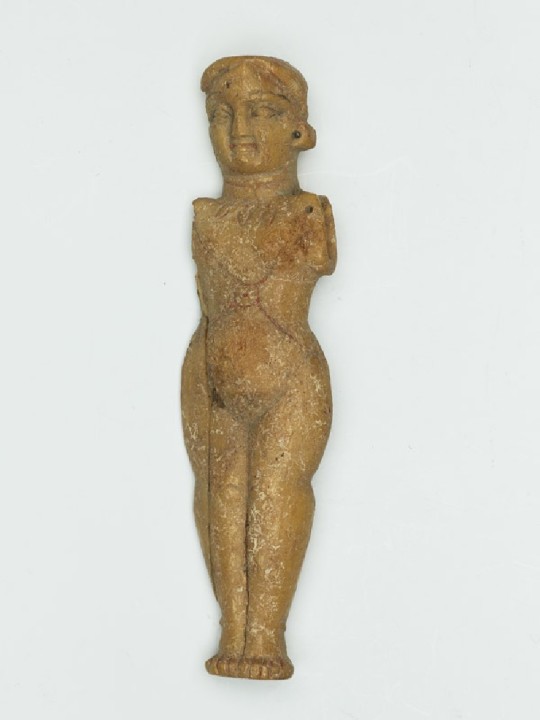







Ai Khanoum 3rd C. BCE - 2nd C. CE. More images on my blog, link at bottom.
"These wise sayings of men of old, The words of famous men, are consecrated At holy Delphi, where Klearchos copied them from carefully To set them up, shining from afar, in the sanctuary of Kineas.
As a child, be well behaved; As a young man, self-controlled; In middle age, be just; As an elder, be of good counsel; And when you come to the end, be without grief.
—trans. of Ai Khanoum stele by Shane Wallace and Rachel Mairs.
Ai-Khanoum (/aɪ ˈhɑːnjuːm/, meaning Lady Moon; Uzbek Latin: Oyxonim) is the archaeological site of a Hellenistic city in Takhar Province, Afghanistan. The city, whose original name is unknown, was likely founded by an early ruler of the Seleucid Empire and served as a military and economic centre for the rulers of the Greco-Bactrian Kingdom until its destruction c. 145 BC. Rediscovered in 1961, the ruins of the city were excavated by a French team of archaeologists until the outbreak of conflict in Afghanistan in the late 1970s.
The city was probably founded between 300 and 285 BC by an official acting on the orders of Seleucus I Nicator or his son Antiochus I Soter, the first two rulers of the Seleucid dynasty. There is a possibility that the site was known to the earlier Achaemenid Empire, who established a small fort nearby. Ai-Khanoum was originally thought to have been a foundation of Alexander the Great, perhaps as Alexandria Oxiana, but this theory is now considered unlikely. Located at the confluence of the Amu Darya (a.k.a. Oxus) and Kokcha rivers, surrounded by well-irrigated farmland, the city itself was divided between a lower town and a 60-metre-high (200 ft) acropolis. Although not situated on a major trade route, Ai-Khanoum controlled access to both mining in the Hindu Kush and strategically important choke points. Extensive fortifications, which were continually maintained and improved, surrounded the city.
Many of the present ruins date from the time of Eucratides I, who substantially redeveloped the city and who may have renamed it Eucratideia, after himself. Soon after his death c. 145 BC, the Greco-Bactrian kingdom collapsed—Ai-Khanoum was captured by Saka invaders and was generally abandoned, although parts of the city were sporadically occupied until the 2nd century AD. Hellenistic culture in the region would persist longer only in the Indo-Greek kingdoms.
It is likely that Ai-Khanoum was already under attack by nomadic tribes when Eucratides was assassinated in around 144 BC. This invasion was probably carried out by Saka tribes driven south by the Yuezhi peoples, who in turn formed a second wave of invaders, in around 130 BC. The treasury complex shows signs of having been plundered in two assaults, fifteen years apart.
Although the first assault led to the end of Hellenistic rule in the city, Ai-Khanoum continued to be inhabited; it remains unknown whether this reoccupation was effected by Greco-Bactrian survivors or nomadic invaders. During this time, public buildings such as the palace and sanctuary were repurposed as residential dwellings and the city maintained some semblance of normality: some sort of authority, possibly cultish in origin, encouraged the inhabitants to reuse the raw building materials now freely available in the city for their own ends, whether for construction or trade. A silver ingot engraved with runic letters and buried in a treasury room provides support for the theory that the Saka occupied the city, with tombs containing typical nomadic grave goods also being dug into the acropolis and the gymnasium. The reoccupation of the city was soon terminated by a huge fire. It is unknown when the final occupants of Ai-Khanoum abandoned the city. The final signs of any habitation date from the 2nd century AD; by this time, more than 2.5 metres (8.2 ft) of earth had accumulated in the palace.
While on a hunting trip in 1961, the King of Afghanistan, Mohammed Zahir Shah, rediscovered the city. An archaeological delegation, led by Paul Bernard, unearthed the remains of a huge palace in the lower town, along with a large gymnasium, a theatre capable of holding 6,000 spectators, an arsenal, and two sanctuaries. Several inscriptions were found, along with coins, artefacts, and ceramics. The onset of the Soviet-Afghan War in the late 1970s halted scholarly progress and during the following conflicts in Afghanistan, the site was extensively looted."
-taken from Wikipedia
...
"The silver ingot engraved with runic characters found during the excavations of the Treasury could suggest they were Sakā/Sai. This inscription comprises 21 characters of a script and a language that are unknown and both attributed to nomadic people of Sakā origin, by comparison with a dozen similar inscriptions coming from an area extending from Ghazni in Afghanistan to Almaty in Kazakhstan, and dated between the 5th century BC and the 8th century AD."
-taken from Ai Khanoum after 145 BC: The Post-Palatial Occupation by Laurianne Martinez-Sève, University of Lille, 2018
#ancient history#antiquities#art#paganism#statue#museums#sculpture#history#greek art#greek gods#ancient greek#greek myth#scythian#pagan#ancient art#afghanistan
215 notes
·
View notes
Text

Iran Police Seize 2 Golden Elamite Masks More than 2000-Years-Old
The Bushehr provincial police chief seized some holy relics, including two more than 2,000-year-old golden masks, in an operation against antiquities smugglers.
The experts of the Cultural Heritage Department estimated that these objects are more than 2000 years old, dating back to the pre-Achaemenid period and the late Elamite period.
“The seized artifacts include two gold masks, a bowl, statues, and several pottery items,” Esmaeel Sajjadi-Manesh stated on Sunday. “Which experts from the provincial office have dated back to the Parthian and Elamite periods.”
“Among the items recovered, one of the most valuable is the gold mask, estimated to be over 2,000 years old,” he noted, “The mask was reportedly being sold for several billion tomans (about 50.000 USD) during the illegal transaction.”
The Elamite Empire is where Bushehr originated, according to research conducted in 1913 by a French excavation team. The Elamite civilization was an ancient culture located in what is now western Iran, existing roughly from 3000 to 500 BCE. Elamites are known for their rich artistic traditions and complex social structures.
Typically, Elamite period golden masks were used in burial rituals as a symbol of the passage to the afterlife. These masks often featured intricate designs and served as representations of the human face, imbued with religious or ritual significance. The craftsmanship of Elamite gold masks showcases detailed workmanship, often incorporating various symbols that reflect their beliefs and values.
These artifacts are very important for the understanding of Elamite culture and for obtaining information about social and religious practices.
By oguz kayra

#Iran Police Seize 2 Golden Elamite Masks More than 2000-Years-Old#gold#gold mask#looted art#stolen art#ancient artifacts#archeology#archeolgst#history#history news#ancient history#ancient culture#ancient civilizations#Elamite history#Elamite empire#Elamite art#ancient art#art history
32 notes
·
View notes
Text
Pub Quiz
People hated it when Mr Stevenson was in the pub during the pub quiz. He was an unpleasant, smug smart-ass. As a teacher at the exclusive public school, he definitely felt like something better. His greasy hair, shapeless figure and old-fashioned clothes did nothing to change that. Mr. Stevenson was simply an unsympathetic person in every respect. And that was why all the visitors to the pub had decided that something had to change. Something fundamental.
"Which ruler founded the Achaemenid dynasty?" asked the moderator of the quiz duel. And again, Mr. Stevenson answered smugly as well as recklessly, "Achaimenes, of course. Otherwise it wouldn't be the Achaemenids, would it?"
"Congratulations!" exclaimed the bartender. "There's a special prize for answering that question!" He handed Mr Stevenson a polo shirt. "Would you do us the pleasure of trying it on right away?"
Even more than showing other people how stupid they were, it pleased Mr Stevenson to get something for nothing. He had also been delighted to get his apple juice for free after the bartender had stained his already coffee-stained shirt while pouring it. Perhaps it was quite appropriate to put on a fresh polo shirt now.
Mr. Stevenson took the polo shirt without a thank you, went to the toilet, took off his shirt and put the polo shirt on over his old stained vest. But instead of the vest, there was suddenly a heavy silver chain. And the rest of his clothes changed too.
"'Can I take a piss right now,' Buck thought to himself. He unbuttoned his jeans and took his magnificent cock out of his jockstrap. On his way back to the bar he was annoyed that it was the pub quiz again. Then the pub was full of arrogant know-it-alls. He was here to have a beer and watch football. He was a caretaker at the community school and the captain of the local rugby team. He didn't need to know all that shit.
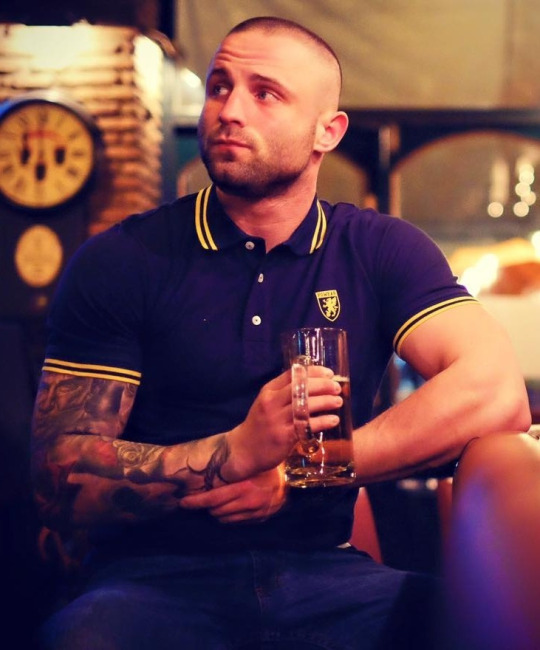
"What name was the King's grandmother known by," was the next question. "The Rottweiler?" wondered Buck. He had no idea. Hopefully the other lads from his rugby team would arrive soon, then they could at least enjoy the evening having a beer or two.
And again, a post by @stargazerguy was the motivation!
193 notes
·
View notes
Text
Try ‘A Companion to the Achaemenid Empire’ from the publisher Wiley Blackwell, it is great
Other ones I know of is ‘From Cyrus to Alexander’ by Pierre Briant, and also The Cambridge History of Iran (which is a large corpus of various books, however it has devoted volumes to the Achaemenian/Mede periods, volume II to be exact)
Hey, so... quick statement in regards to my queer historical monster romance story A Tiger of Persia:
I'm a white, Western writer, and the characters I'm depicting are not. I don't know a huge amount about Achaemenid-era Persia (most of what you see in the story so far is drawn from Wikipedia), and although I fully plan to continue the story to its end I don't want to accidentally stray into the realm of exoticism, orientalism, or other objectification of a culture not my own. Therefore, what you're going to see of A Tiger of Persia here on tumblr is the first draft.
After that first draft is complete, it will stay here on tumblr forever (don't worry) but I want to read a few books about ancient Persia and then re-write the entire thing to be more historically accurate and nuanced. My reading list so far is:
Creation by Gore Vidal
The Persian Empire by John Manuel Cook
If you have any suggestions or additions for this list, please let me know! I'd love to hear from you.
#ancient iran#achaemenid empire#ancient persia#Hope this helped#ALSO stay away from lloyd llewellyn-jones he is… icky…#Also OP if I may offer one advice concerning the drafts of your story on the blog — it looks good! but maybe to be more historically#accurate you could use Old Persian Elamite or Mesopotamian names 🤔#So it’d be more contemporary with the time
8 notes
·
View notes
Text

Gate of All Nations The Gate of Xerxes -UNESCO World Heritage (r. 486 – 465 BC) Persepolis - IRAN
The bronze trumpets that once signaled the arrival of important foreign delegations to Persepolis, the ceremonial capital of the mighty Achaemenid Empire, may now be silent, but it is still possible to capture the sense of awe while visiting the colossal Gate of Xerxes.
Built during the reign of Achaemenid king Xerxes I , who called this his Gate of All Nations, the pillared entrance is guarded by bearded and hoofed mythical figures in the style of Assyrian gate-guards.
On arrival at Persepolis one is confronted by an imposing wall, completely smooth and plain, about 15 meters tall: this is the artificial terrace on which the palaces were built. This vast terrace of Persepolis, some 450 meters long and 300 meters wide, was originally fortified on three sides by a tall wall. The only access was from the monumental staircase, which leads to the Gate of All Nations.
The gateway bears a cuneiform inscription in Old Persian, Neo-Babylonian, and Elamite languages declaring, among other things, that Xerxes is responsible for the construction of this and many beautiful wonders in Persia. Centuries of graffitists have also left their mark, including explorer Henry Morton Stanley.
A pair of colossal bulls guarded the western entrance; two man-bulls stood at the eastern doorway. Engraved above each of the four colossi is a trilingual inscription attesting to Xerxes having built and completed the gate. The doorway on the south, opening toward the Apadana, is the widest of the three.
According to sources, pivoting devices found on the inner corners of all the doors indicate that they must have had two-leaved doors, which were probably made of wood and covered with sheets of ornamented metal.
Persepolis, also known as Takht-e Jamshid, whose magnificent ruins rest at the foot of Kuh-e Rahmat ("Mountain of Mercy"), was the ceremonial capital of the Achaemenid Empire. It is situated 60 kilometers northeast of the city of Shiraz in Fars Province.
Persepolis was the seat of the government of the Achaemenid Empire, though it was designed primarily to be a showplace and spectacular center for the receptions and festivals of the kings and their empire.
The royal city ranks among the archaeological sites which have no equivalent, considering its unique architecture, urban planning, construction technology, and art.
The city was burnt by Alexander in 330 BC apparently as revenge to the Persians
The immense terrace of Persepolis was begun about 518 BC by Darius the Great, the Achaemenid Empire’s king. On this terrace, successive kings erected a series of architecturally stunning palatial buildings, among them the massive Apadana palace and the Throne Hall (“Hundred-Column Hall”).
This 13-ha ensemble of majestic approaches, monumental stairways, throne rooms (Apadana), reception rooms, and dependencies is classified among the world’s greatest archaeological sites.
#art#design#doorway#architecture#heavensdoorways#gateway#entryway#iran#persepolis#bull#royal#royal city#style#history#gates of xerses#unesco world heritage#monumental#gate of all nations#achaemenid#persia#xerxes#front door#architrave
84 notes
·
View notes
Photo

Alexander the Great & the Burning of Persepolis
In the year 330 BCE Alexander the Great (l. 356-323 BCE) conquered the Achaemenid Persian Empire following his victory over the Persian Emperor Darius III (r. 336-330 BCE) at the Battle of Gaugamela in 331 BCE. After Darius III's defeat, Alexander marched to the Persian capital city of Persepolis and, after looting its treasures, burned the great palace and surrounding city to the ground, destroying hundreds of years' worth of religious writings and art along with the magnificent palaces and audience halls which had made Persepolis the jewel of the empire.
The City
Persepolis was known to the Persians as Parsa ('The City of the Persians'), and the name 'Persepolis' meant the same in Greek. Construction on the palace and city was initiated between 518-515 BCE by Darius I the Great (r. 522-486 BCE) who made it the capital of the Persian Empire (replacing the old capital, Pasargadae) and began to house there the greatest treasures, literary works, and works of art from across the Achaemenid Empire. The palace was greatly enhanced (as was the rest of the city) by Xerxes I (r. 486-465 BCE, son of Darius, and would be expanded upon by Xerxes I's successors, especially his son Artaxerxes I (r. 465-424 BCE), although later Persian kings would add their own embellishments.
Darius I had purposefully chosen the location of his city in a remote area, far removed from the old capital, probably in an effort to dramatically differentiate his reign from the past monarchs. Persepolis was planned as a grand celebration of Darius I's rule and the buildings and palaces, from Darius' first palace and reception hall to the later, and grander, works of his successors, were architectural masterpieces of opulence designed to inspire awe and wonder.
In the area now known as the Marv Dasht Plain (northwest of modern-day Shiraz, Iran) Darius had a grand platform-terrace constructed which was 1,345,488 square feet (125,000 square meters) big and 66 feet (20 meters) tall and on which he built his council hall, palace, and reception hall, the Apadana, featuring a 200-foot-long (60 meters) hypostyle hall with 72 columns 62 feet (19 meters) high. The columns supported a cedar roof which was further supported by cedar beams. These columns were topped by sculptures of various animals symbolizing the king's authority and power. The Apadana was designed to humble any guest and impress upon visitors the power and majesty of the Persian Empire.
Darius I died before the city was completed and Xerxes I continued his vision, building his own opulent palace on the terrace as well as the Gate of All Nations, flanked by two monumental statues of lamassu (bull-men), which led into his grand reception hall stretching 82 feet (25 meters) long, with four large columns 60 feet high (18.5 meters) supporting a cedar roof with brightly decorated walls and reliefs on the doorways. The city is described by the ancient historian Diodorus Siculus (l. 1st century BCE) as the richest in the world and other historians describe it in the same terms.
Continue reading...
81 notes
·
View notes